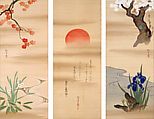Returned to lender The Met accepts temporary loans of art both for short-term exhibitions and for long-term display in its galleries.
The Rising Sun with Flowers and Trees of the Four Seasons
Sakai Hōitsu Japanese
(and poem) by Kazan’in Yoshinori Japanese
Not on view
Flanking the central scroll with an auspicious image of the rising sun are two scrolls depicting flowers and trees of the four seasons. Cherry and maple, representing spring and fall, appear in the upper sections of the paintings, while irises, pond lilies, narcissus flowers, and bamboo appear below, symbolizing summer and winter. The juxtaposition of the summer stream with the ice-glazed river unifies the composition, for the bodies of water fall away from the center in complementary arcs that echo the round form of the sun.
The poem inscribed over bands of golden mist is by the courtier-calligrapher Kazan’in Yoshinori. The lavish painting may have been commissioned to commemorate his retirement from court life, with the sun, a symbol of imperial beneficence, illuminating the four quarters and the flora of the four seasons. The poem, a thirty-one-syllable waka, draws on traditional symbolism likening the rising sun to the imperial presence:
Akirakeki
miyo zo to yomo ni
shirashimete
terasu hikage no
kumoru toki naki
Praise for the enlightened
reign of the emperor
spreads in all directions,
just as the light of the sun
shines in a cloudless sky.
—Trans. John T. Carpenter
Due to rights restrictions, this image cannot be enlarged, viewed at full screen, or downloaded.
This artwork is meant to be viewed from right to left. Scroll left to view more.





